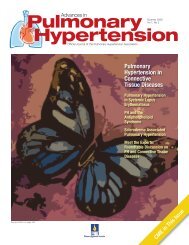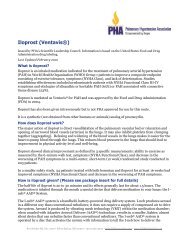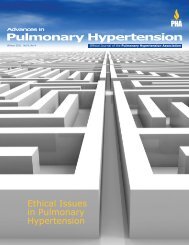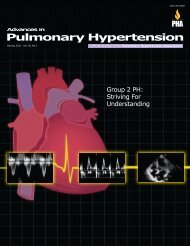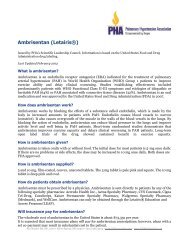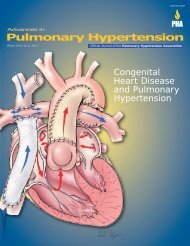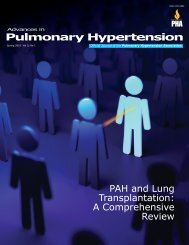Vol 7, No 3 - PHA Online University
Vol 7, No 3 - PHA Online University
Vol 7, No 3 - PHA Online University
Create successful ePaper yourself
Turn your PDF publications into a flip-book with our unique Google optimized e-Paper software.
Survival probablility (%)<br />
13<br />
12<br />
11<br />
10<br />
9<br />
27<br />
26 25<br />
8<br />
7<br />
6 5<br />
4<br />
5<br />
3<br />
24<br />
5/27 patients<br />
25<br />
23<br />
2<br />
22<br />
0<br />
0<br />
11/13 patients<br />
Delayed Enhancement<br />
Mass (g/m 2 )<br />
Figure 2. Gadolinium delayed enhancement is seen essentially at RV insertion<br />
site. Right graph shows no difference in scar mass between idiopathic<br />
PAH and PAH-SS patients.<br />
<strong>No</strong>te: 11 of 13 patients with hyponatremia who died had sclerodermarelated<br />
PAH.<br />
4.0<br />
3.0<br />
2.0<br />
1.0<br />
0<br />
IPAH<br />
PAH-SSc<br />
Time (months)<br />
PAH-SSc<br />
Figure 1. Kaplan and Meier estimates of survival (all-cause mortality)<br />
in patients stratified by serum sodium.<br />
that our data will provide new insights into the molecular basis for<br />
rational strategies for patients who have scleroderma-related PAH,<br />
and elucidate the relationship of RV-PV dysfunction to the activation<br />
of pathological gene expression in genetically susceptible<br />
patients.<br />
In summary, the Hopkins SCCOR application represents a consortium<br />
of investigators with multidisciplinary expertise. The common<br />
goal to use state-of-the-art physiological, molecular, and<br />
genomic and proteomic approaches as well as novel phenotyping<br />
instrumentation that will provide the deepest understanding of<br />
the critical pathobiological processes of RV-PV dysfunction and<br />
uncoupling to date, and define key genetic determinants relevant<br />
to scleroderma-related PAH. The 5 human and animal projects<br />
are supported by 6 highly interactive cores (administration, data<br />
management/bioinformatics, molecular pathology, genomic and<br />
genotyping, proteomics, and imaging). We anticipate our work will<br />
provide a foundation for meaningful translational research that<br />
will facilitate development of new strategies, uncover therapeutic<br />
targets, and define new biomarkers and prognostic indicators that<br />
will limit the current dismal outcome of scleroderma-associated<br />
PAH.<br />
Progress<br />
The major goals of this SCCOR project are to develop reliable<br />
measures of RV-PV function, to characterize patterns of gene expression<br />
and identify candidate gene polymorphisms associated<br />
with susceptibility to PAH, and to use these tools to guide therapy<br />
aimed at RV-PV dysfunction in scleroderma-related PAH. As part<br />
of our SCCOR activities, we have recently demonstrated that hyponatremia<br />
is a significant indicator of survival (Figure 1) in patients<br />
with PAH, in particular in patients with scleroderma-related<br />
PAH. 1 Hyponatremia is 9 times more likely to be present in scleroderma-related<br />
PAH when controlling for hemodynamics and renal<br />
function, which suggests that up-regulation of the renine-aldosterone-angiotensin<br />
system (RAAS) in response to hemodynamic<br />
stress from PAH differs between idiopathic PAH and sclerodermarelated<br />
PAH. Based on this and other clinical findings that indicate<br />
the involvement of RAAS activation in scleroderma-related PAH,<br />
some members of our team are focusing their effort on genes pertinent<br />
to neurohormonal activation such as adreno-medullin.<br />
Characterizing RV-PV Function<br />
To characterize optimal measures of RV-PV function in scleroderma-related<br />
PAH we use a combination of hemodynamic data<br />
obtained from right heart catheterization data, echocardiographic<br />
parameters, and cardiac MRI with gadolinium imaging and stress<br />
test (adenosine infusion). We compare these data to patients with<br />
idiopathic PAH. RV function is an important determinant of prognosis<br />
in pulmonary hypertension as it is the single most significant<br />
prognostic marker of survival. In a prospectively studied cohort of<br />
63 consecutive patients with PH who were referred for a clinically<br />
indicated right heart catheterization we demonstrated that the degree<br />
of tricuspid annular displacement (tricuspid annular plane<br />
systolic excursion or TAPSE) powerfully reflects RV function and<br />
prognosis in PAH. 2 Specifically, we demonstrated that a low<br />
TAPSE value of less than 1.8 cm was associated with greater RV<br />
systolic dysfunction, more RV remodeling, and right ventricle-left<br />
ventricle disproportion. More importantly, this study demonstrated<br />
that TAPSE could predict survival when these patients were followed<br />
over time on therapy. This is now a widely quoted study<br />
among the PH community.<br />
In addition, we have focused on several cardiac MRI parameters<br />
obtained prospectively and within 2 to 4 hours of right heart<br />
catheterization. Pulmonary distensibility is of interest because of<br />
the potential of increased fibrosis that can cause stiffening of the<br />
proximal pulmonary arteries in scleroderma-related PAH and contribute<br />
to RV-PV uncoupling. This analysis has generated some<br />
intriguing results comparing scleroderma patients with and without<br />
PAH and controls. We have also focused on myocardial scarring<br />
in PAH patients and postulated that patients who have<br />
scleroderma-related PAH might have increased scar mass compared<br />
to patients with idiopathic PAH. Although we found no difference<br />
in scar mass between the 2 groups (Figure 2), scar mass<br />
as assessed by cardiac MRI correlated strongly with RV end diastolic<br />
volume in patients with scleroderma-related PAH but not in<br />
those with idiopathic PAH (Table).<br />
Candidate Genes for Scleroderma-Related PAH<br />
We have published our first observation for the use of genomic<br />
profiling in patients with scleroderma-related PAH (compared with<br />
patients who have idiopathic PAH). Briefly, we hypothesized that<br />
PAH-associated genes identified by expression profiling of peripheral<br />
blood mononuclear cells from patients with idiopathic<br />
PAH can also be identified in peripheral blood mononuclear cells<br />
338 Advances in Pulmonary Hypertension



